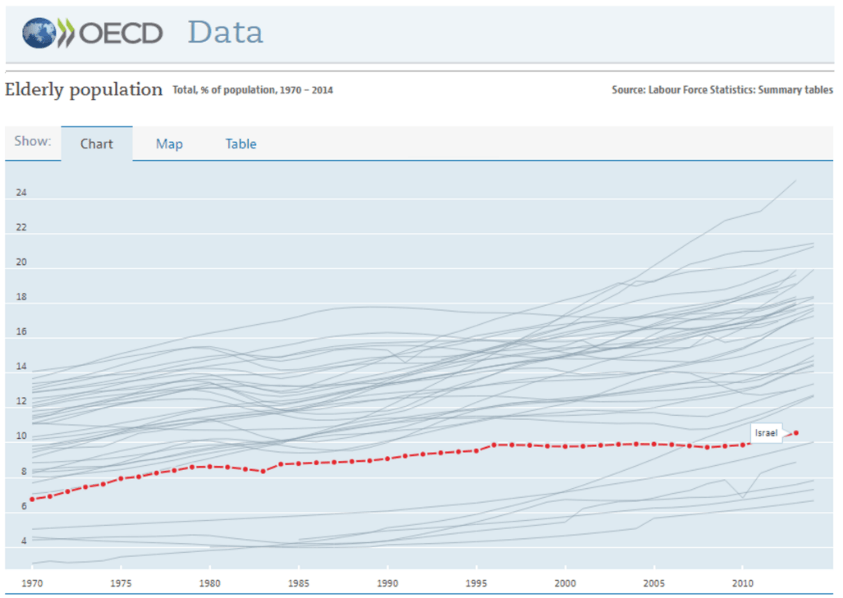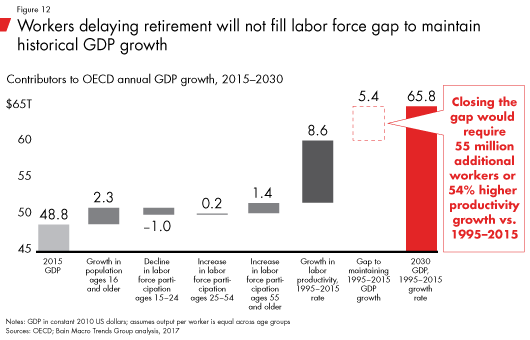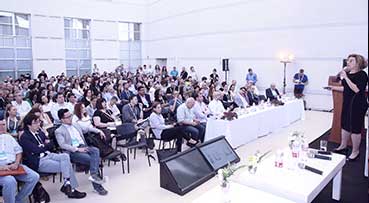The business world takes the abundance of labor for granted. Throughout most of our careers we have seen global labor markets growing. But in the next couple of decades this situation is going to change. The majority of the world’s working population is aging, which in turn will impact the availability of labor. And this availability has fueled economic growth since the 1970’s. Thanks to a longer and healthier lives many people today work into their sixties and beyond. But delayed retirement in itself will probably not be able to balance the negative impact of the aging population. Unless we do something about it.
Ever since the 1950’s, about a third of the growth in the OECD and half of the growth in the US was generated as a result of the increase in the available labor. Three forces drove this growth. The first was powered by the women who entered the world of work. In the 1950’s only 35%-43% of the women in the US and the OECD were employed, compared to about 75% today. The second trend that contributed to the growth of the labor force was the fact that China and India opened themselves up to the global economy, adding 1.3 billion new workers on top of the growth in trade. But the most significant force affecting this growth was the overall growth of the labor force as a result of the baby boomer generation, born after World War II. Its significant size can be attributed to the emergence of vaccines and antibiotics on the one hand, and the absence of the pill as a preventive measure on the other. When this generation entered the world of work in the 1970’s, developed countries doubled their growth by two percent annually.
A new report by the consulting firm Bain analyzes, among other things, the implications of these demographic changes on labor markets and through them on global economies. The report marks the fact that in the next few years, the same number of workers who have driven this growth will also leave the labor markets. True, longer lives and good health will somewhat delay this process. But on the other hand, we are seeing that the younger generation, the 20-year-olds, join the labor market later in life. This is a result of longer years of studies and the delay of economic independence, both due to increase in education and housing costs.
Therefore, in the coming decades, we are likely to see in the OECD countries for the first time in history, the 65+ population grow faster than the working population. As a result, the US job market growths is expected to slow down to about half a percent annually and the job market growth in Europe is generally expected to be negative. We cannot ignore the impact of this trend on economic growth. According to the Bain report, considering the changes in labor markets on both sides, both the rate of entry of young workers and the pace of retirement of older workers, 55 million workers are missing in the market to maintain the existing growth rate.
Initially one might think that this is good news for employees. After all, a shortage of workers will increase their value, at least in the short term, and organizations will increase their efforts to recruit, train and retain good employees, improve employment conditions, management and even culture. In a world where work is not necessarily place-dependent, employers also seem to be improving flexible employment opportunities, which could expand the circle of workers beyond geographical boundaries and open possibilities for populations who are farther away from business centers. Other possible solutions may include lifting of barriers to immigration, incentives to increase the employment of women and other populations, which are today still not fully present in the labor market.
But these changes in the economy also create risks to workers. Economic growth depends on worker availability as well as on their productivity. In other words what we are all able to create depends on how many workers are available and on how good, productive, efficient they are. Therefore, if there are fewer workers we can expect companies to replace workers with technology. To begin with, those workers, who have average or low skills will find themselves replaced by technologies introduced in order to increase productivity and address the shortage of working hands. And as technology evolves, this trend will rise up the value chain and more and more roles and professions will see technology capable of doing increasing portions of their roles.
Clearly there is a need for updated public policy to address these changes, especially those targeted at what we today call the retirement years. We can already observe the almost automatic response by policy makers, the upward correction of the legal retirement age for pensions. This reaction unilaterally shifts the problem over to the workers, who now need to support themselves financially over a longer career years. And as we can see, these workers are already beginning to understand that there is no choice. A report by the Center for Economics and Business in the UK reveals that more and more of the 50+ workers are shifting to independent work structures. For the first time in 2016, 50-plus-owned businesses employed more workers than those with younger owners. This trend reinforces one of the recommendations in the OECD series “Working Better with Age“, to plan ahead and ensure we have training and education systems in place, to help people in mid-life career transitions ensure their skills and capabilities are updated and aligned for the many more years to come. And this includes not only upskilling in existing professions but also the ability to update skills, transition to new professions and industries as well as new ways of work.
In the UK, for example, the government aims to increase the workplace participation of older workers, ages 50-69, by 12% by 2022 for all employers(!). This is a result of the same forces, as the UK realizes they need more than 14 million jobs and expect only 7 million young people to join the labor market. The simple math showed that if the employment level of those aged 50-69 is equal that of those aged 35-49 the result will be an addition of more than 5% to the GNP. And workers over 50 are already over one-third of the workforce and about half of the adult population, making the economic reasons for policy changes obvious.
An organization called Business in the Community received ownership for this strategy and it lists additional business justification for such policy, beyond the worker availability issue already covered. Similar to the business case for diversity and inclusion, the argument here too is that since half of the population is over the age of 50, organizations need to have workers in this age group to service their customers. And there is also the simpler statement that employees with 20 or more years of experience have relevant experience and capabilities, a desire and ability to contribute their knowledge and experience, and the ability to diversify thinking in the organization with other perspectives, maturity and an attempt to cope with a wide range of situations and people. They are also more loyal, exhibit fewer absences and less turnover.
This effort seems to be working. Barclays Bank, for example, says on its website that it is expanding its programs for older workers and creating a program called “Welcome Back” for women who have left the job market in order to raise a family and would now like to reenter the workplace. A study at the University of Manchester revealed that about a quarter of the people, who defined themselves as retired, returned to the labor market within a decade, coining the term “Unretire”. In the US, for example, some organizations are discovering the advantage of this population for example when short term hiring is needed, such as in the case of the retail world during the holidays. This isn’t about exploitation but considers that for some people prefer returning for temporary work from time to time, which earned them the name “Boomerangers”.
In New York, the Age Smart prize is awarded to organizations, designed to encourage and disseminate practices that promote the employment of older workers. The 2018 winners, for example, include an electric company, which charts career paths for people, who choose with time to leave the field for office work, including budgets and time allocated for academic training. A winning health services company provides services in difficult neighborhoods and makes sure to recruit employees from these neighborhoods, mentor them and see them through training and career paths.
In the local high-tech industry we see this trend playing out as well. On the one hand, there is a shortage of qualified employees and on the other hand we keep hearing about older workers losing jobs and having a hard time finding new ones in the industry. One of the reasons cited for this is the skills gap, where older employees no longer have updated skills, to qualify them for the new jobs. However, in recent years we can see a shift in this space, as some of these older workers learn new technologies and the industry recognizes that even when their direct experience may be short, they compensate by being able to ramp more quickly into the organization compared to younger employees out of Coding School with no work experience.
There are still very little new or creative corporate plan in this space. But the business case is clear and we can therefore expect to see a response in both national and organizational levels. Even if not only because it is simply the right thing to do as human beings and as a society, then because there is no other option, for there will simply not be enough workers for all the work we need to get done and it will be impossible not to use those who are available, willing and capable. Economic policy will have to address the fact that this process should be aided not only with sticks, but also with carrots. And certainly not leave all responsibility with the employees.
Published in Globes Israel Business Arena



![large-AX1A2125-2[1] large-AX1A2125-2[1]](https://niritcohen.com/wp-content/uploads/elementor/thumbs/large-AX1A2125-21-pnzedcs72atx5aeurqytqdiihxixlq02re9mlz805s.jpg)






